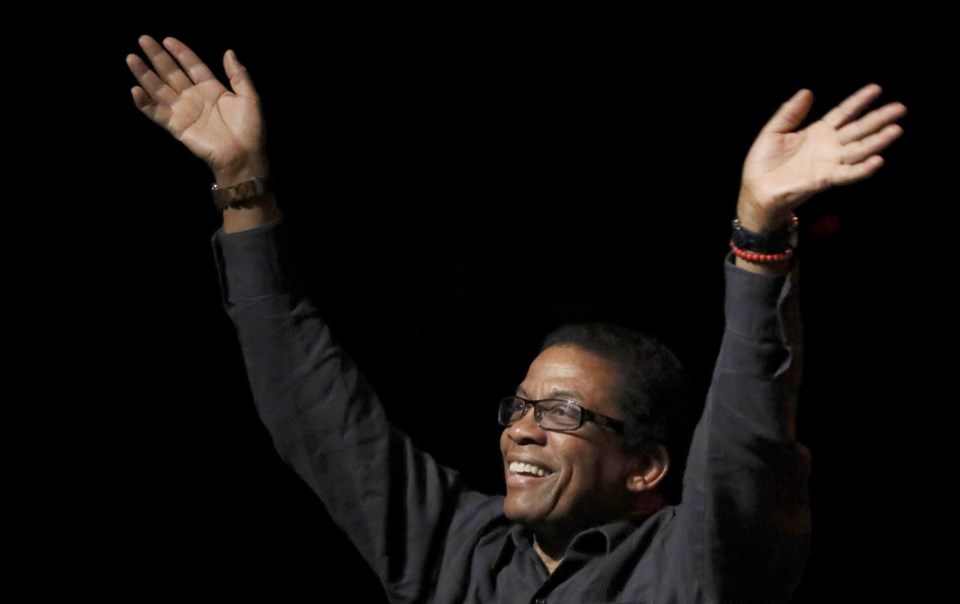Herbie Hancock likes to surprise us.
Remember when the post-bop stalwart went funk/soul/jazz on Head Hunters in 1973? Remember when he went hip-hop/jazz with the 1983 dance-club instrumental smash Rockit with its freaky futuristic video? Remember when he got Tina Turner, Norah Jones, Wayne Shorter and others to interpret Joni Mitchell songs in 2007 and won an album-of-the-year Grammy for it?
Well, the jazz keyboard giant has another surprise in the works. A new album that’s hard to describe.
“There are a lot of different people from different cultures, different genres, different generations,” said the 77-year-old. “I like the idea of expressing music that is designed to show what can happen creatively when we’re working together and the beauty of bringing humanity together.”
The lineup of collaborators is diverse and deep: enduring rapper Snoop Dogg, Happy hitmaker Pharrell Williams, hip, versatile bassist Thundercat, tabla master Zakir Hussain and younger jazz stars Robert Glasper, Jamire Williams and Kamasi Washington.
“We’re playing some of the pieces we’re working on in our live show,” Hancock said.
When he’s onstage, Hancock tries not to think but to play.
“The music is like one living being and we’re all like fingers playing this imaginary, many-faceted instrument,” he explained from his Los Angeles office recently. “You’re so focused on being connected to the rise and fall of the music, even the spaces between the notes, the harmonies, the rhythm. Even though that sounds like an intellectual pursuit, the process is more about doing and not so much about thinking.”
The turns and twists in Hancock’s long career — he started as a child prodigy playing a Mozart piano concerto with the Chicago Symphony Orchestra at age 11 — have produced some surprises that weren’t musical.
Such as when he acknowledged his crack addiction in his 2014 memoir, Possibilities.
“Both my wife and daughter encouraged me to write about it in the book,” he said. “I’d been trying to shove that out of my mind like a dark period I wanted to bury.
I realized that never works. It’s like being in denial.
“Some people have told me they were helped by the book. So I feel good about revealing the truth about what happened in my life as an addict. And I won. I beat it.”
Hancock can get all philosophical, which he did during a series of six lectures at Harvard University in 2014. He was appointed to the Norton professorship of poetry, an award that had previously gone to the likes of Leonard Bernstein, Igor Stravinsky and John Cage.
“I was talking about the ethics of jazz that are in harmony with being a human being,” Hancock explained. “In jazz, we don’t judge what each of us plays. We try to make everything work. No matter what anyone plays, we try to make it be part of the music. That’s being nonjudgmental. We share ideas, we’re not competing with each other. It’s really healthy and it’s giving and extremely rewarding.
“There’s a tendency for artists to feel special because you have a gift,” he continued. “So sometimes they put themselves on a pedestal or the audience puts them on a pedestal. The truth is the most difficult art to master is the art of living. And everyone has to deal with that.”
Meeting Miles
Having started classical piano lessons at age seven in his hometown of Chicago, Hancock began his jazz career in earnest after studying engineering and music at Grinnell College in Iowa.
His 1962 debut album for Blue Note, Takin’ Off, featured Hancock’s piece Watermelon Man, which Cuban percussionist Mongo Santamaria turned into an instrumental pop hit a year later. (Hancock rerecorded it as a funk piece on Head Hunters and it’s now become a jazz standard.)
More importantly, the album caught the attention of trumpet star Miles Davis, who invited Hancock to join his new band, known as Davis’ second great quintet, featuring saxophonist Shorter and the young rhythm section of bassist Ron Carter and teen drummer Tony Williams.
“The cool thing about Miles is that he didn’t want to tell you what to do specifically,” Hancock recalled. “He wanted to stimulate you to use your own devices and figure out what to do. So he would do something to start you on a path toward looking for a solution.”
Hancock spent five years with Davis while also making albums under his own name and playing on sessions with other bandleaders. In addition, he recorded TV commercials and movie soundtracks, beginning with Blow Up in 1966. Hancock has released 41 studio albums under his own name. He has collected 14 Grammys, one Oscar (for 1986’s Round Midnight), a Kennedy Center Honors (2013) and a Grammy for Lifetime Achievement (2016).
The ever-busy Hancock is a professor at UCLA and creative chair for jazz for the Los Angeles Philharmonic. But he doesn’t practise piano every day.
“I chant every day. Twice a day. I’m a Buddhist. My life isn’t just music.”
Prince encounters
While Hancock has worked with everyone from pop star Pink and hip-hop superstar Kanye West to classical piano star Lang Lang and guitar god Carlos Santana, he never recorded with Prince. But they did jam together and become friends when Prince lived in Los Angeles in the early 2000s.
Prince often hosted parties and Hancock would be on the guest list with the likes of Samuel L. Jackson, Leonardo DiCaprio and Penelope Cruz.
“Sometimes I’d bring Joni Mitchell with me. He worshipped her,” Hancock said of Prince. “It was a lot of fun to go to Prince’s house and play. The place would be rocking out. He loved improvising.”
There also were “deep conversations” about religion, philosophy, music or books people read. Sometimes the proceedings would carry on until early morning when the sun was up. And — surprise — they’d have breakfast at Prince’s.
“Then,” Hancock said, “we’d go home completely tired.”



